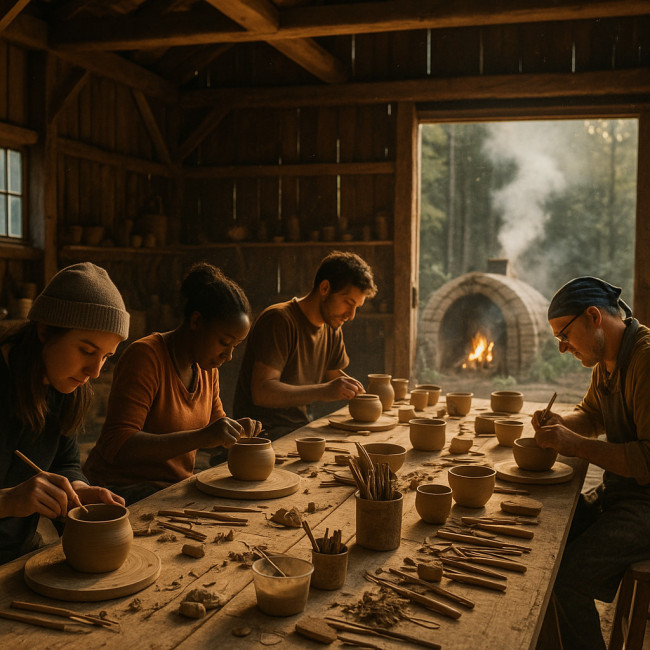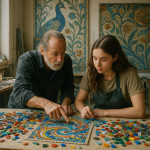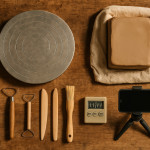Skill-building roadmap for ceramists: residencies, labs and peer mentoring
You want to push your ceramic practice further but feel swamped by the sheer volume of workshops, residencies and online classes. This roadmap condenses the options into three powerful pillars—immersive residencies, focused lab work and peer mentoring—so you can design a year-round, budget-smart learning plan that actually sticks.
Why a structured skill-building plan accelerates growth
Jumping from one random tutorial to the next rarely produces transformative results. A clear skill-building roadmap for ceramists provides three benefits:
- Momentum – each learning block feeds the next, avoiding creative plateaus.
- Accountability – progress is measured against concrete milestones, not vague wishes.
- Strategic visibility – residencies, lab results and mentoring testimonials enrich your portfolio and attract commissions, whether it is hospitality projects or corporate gifting lines.
Stage 1 : Define your learning goals
Self-assessment checklist
Before booking the next clay class, rate your confidence (1–5) for each area:
- Throwing consistency above 1 kg
- Slab building for functional forms
- Glaze chemistry and colour prediction
- Kiln-firing schedules for mixed clay bodies
- Digital modelling / 3-D printed moulds
- Pricing and production planning
Scores of 1-2 mark your priority gaps. Flag no more than three gaps per quarter to stay focused.
Stage 2 : Tap residencies for immersive learning

Picture a sun-lit rural workshop where half-finished teabowls dry on pine boards while visiting artists discuss firing curves beside an ancient anagama kiln; that atmosphere sums up why residencies function as fast-track incubators. Far from daily distractions, you gain uninterrupted hours, cross-pollinate ideas with peers from five continents, and absorb local material culture—from clay deposits to firing folklore—that would take years to gather alone.
Residencies compress months of independent trial-and-error into a few intensive weeks thanks to mentorship, peer critique and dedicated studio time. Thousands exist worldwide—from rural anagama kilns to urban digital fab-labs—so compare before you apply.
| Residency type | Duration | Main perks | Typical cost or stipend |
|---|---|---|---|
| Institutional (museum) | 4–12 weeks | Access to archives, exhibitions | $1 000 – $2 000 stipend |
| Rural kiln collective | 2–6 weeks | Wood or gas kiln firings, local clay digs | $500 fee + materials |
| University research lab | 1–2 semesters | Glaze chemistry, material scientists on site | Free; housing extra |
| Industry-sponsored | 1–4 weeks | Prototype facilities, marketing support | $1 500 stipend + production budget |
Many ceramists discover programs via the specialised craft training directory where filters reveal deadlines, stipends and required portfolio size in seconds.
Application tips that win seats
- Anchor your project to a research gap—for example “developing shino glazes adaptable to electric kilns.”
- Match resources: if the host offers a soda kiln, propose tests that need that atmosphere.
- Explain community return—artist talk, open studio or workshop—showing you amplify their visibility.
Stage 3 : Laboratory time—turn experiments into repeatable formulas
Back from a residency, jump into a structured lab phase. Whether you use a university facility, shared makerspace or your home studio, the goal is to convert notes into documented, test-fired results.
Four-week lab sprint
- Batch small tiles – mix three clay bodies and label clearly.
- Glaze matrix – vary silica / alumina ratios by 5 % each row.
- Fire & document – record cone bends, ramp speeds, hold times.
- Analyse and publish – share on Instagram Stories or newsletter; potential clients love seeing your technical rigour.
Need extra hands for sanding, mixing or photography? Explore how to hire a studio assistant for short bursts without bloating payroll.
Stage 4 : Peer mentoring—critical feedback without the ego bruises
A study by the International Ceramic Artists Network shows makers who participate in quarterly peer critiques ship 35 % more finished pieces annually. Done right, mentoring fills the gap between isolated studio time and formal education.
Set up a three-month mentor cycle
- Match wisely – choose a peer one skill tier above you in your weakest area.
- Define deliverables – e.g., “Review 10 test tiles and a costed production spreadsheet.”
- Meet rhythmically – two video calls + one shared Google Doc per month keeps momentum.
If you sell through fairs or pop-ups, invite mentors to your booth for live feedback. Their fresh eyes sharpen display and pricing strategies in line with event-marketing tactics that convert browsers into buyers.
Timeline template : integrate residencies, labs and mentoring
- Q1 – Discovery & application writing
- Q2 – 4-week residency + peer mentor kickoff
- Q3 – Lab sprint + small-batch production
- Q4 – Market test pieces, review results, re-apply for advanced residencies
Cycle repeats, each loop compounding both technical mastery and market reach.
Quick knowledge check
FAQ
- How many residencies should I apply to each year?
- Most mid-career ceramists target 3-5 programs to secure one slot. Diversify regions and funding models to raise your odds.
- Can I combine a residency with client work?
- Yes, but plan for limited bandwidth. Schedule client deadlines two weeks before your departure and set automated replies to manage expectations.
- What if I lack access to a university lab?
- Shared makerspaces or community colleges often rent kiln time. Alternatively, join a firing co-op and split fuel and maintenance costs.
- How do I find suitable mentors?
- Start with former teachers, residency alumni or the critique forums inside ICAN. Offer skill swaps—photography help for feedback, for example.
- Is peer mentoring useful for business skills too?
- Absolutely. Invite mentors who excel at pricing, wholesale logistics or online marketing to review your cost sheets and product descriptions.
Take action today
Block one hour this week to map your Q1 goals, shortlist three residencies and message a potential mentor. Each small step compounds into the mastery—and market visibility—you crave.
Ready to deepen your craft? Bookmark this roadmap, share it with your studio circle and start applying now.











